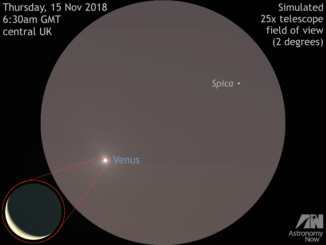
Virgo



Don’t miss the largest supermoon of 2020 on 8 April
The full Moon of 8 April 2020 occurs just 8½ hours after perigee, its closest point to Earth in the oval-shaped lunar orbit. A full Moon occurring close to perigee is popularly called a supermoon, and this one will be 8½ percent larger than average. This is also the closest full Moon of the year and we’ll not see one larger until 5 November 2025.

See Mercury at its best meet Mars in the dawn sky
Innermost planet Mercury puts on its best morning display of the year for Northern Hemisphere observers from late November to early December. Skywatchers in the British Isles should find a location offering an unobstructed view of the southeast horizon about 45 minutes before sunrise to get the best views, with the Red Planet and star Spica – the brightest in Virgo – also nearby.

Seek out 3C 273, the brightest optical quasar, in the spring sky
Plumb the hidden depths of spring’s deep-sky by seeking out 3C 273, the optically-brightest quasi-stellar object (QSO) in the constellation of Virgo. Quasars are the intensely luminous centres of very distant and active galaxies, powered by a supermassive black hole. And don’t worry that you need a huge ‘scope to see it – a 15-cm (6-inch) instrument and a clear, moonless night are all you need.

Catch Venus near bright star Spica in the dawn sky
Find a location that offers you an unobstructed view of the southeast about an hour before sunrise in the UK over the next week to see dazzling Venus close to the horizon. Look carefully at the planet around 6:30am GMT on 15 November and you’ll see it close to first-magnitude Spica, Virgo’s brightest star.

See bright near-Earth asteroid 2017 VR12 pass close to star Spica, 7–8 March
Possibly as large as The Shard in London, Apollo asteroid 2017 VR12 passes just 3¾ lunar distances from Earth at 7:53am GMT on 7 March. For a few nights, this magnitude +12 space rock is a viable target for small backyard telescopes as it gallops through Coma Berenices and Virgo, passing just 0.8 degrees from Spica on the UK night of 7–8 March.

See bright near-Earth asteroid 2002 AJ129 dash through Virgo and Leo, 5–7 February
Possibly a kilometre or more in size, Apollo asteroid 2002 AJ129 passes just 10.9 lunar distances from Earth at 21:30 UT (9:30pm GMT) on 4 February — its closest approach for 114 years. For a few nights around this date the magnitude +12.6 body is well placed for observers as it gallops through the constellations of Virgo and Leo into Cancer at a rate of up to 40 degrees/day. We show you where and when to look for it.

See the Moon and planets gather at dawn
It currently pays to be an early riser if you wish to view the planets, for it’s all happening at dawn in the skies of Western Europe. Find innermost planet Mercury, see a near miss of Mars and Jupiter on 7 January, then a fabulous binocular conjunction of the waning crescent Moon, the Red planet and Jupiter on 11 January!

